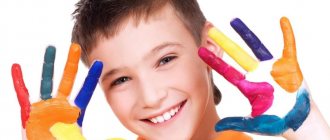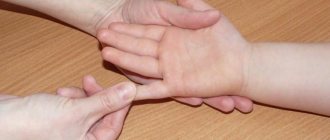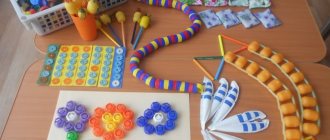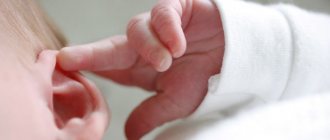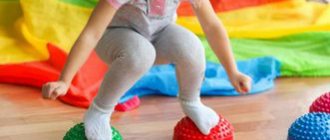Fine motor skills - what is it and how does it affect the child’s condition?
Imagine picking up a tennis ball and a grain of rice. Agree, it’s much easier and faster to grab the ball: close your fingers and you’re done. Whether it’s raising a small grain, you need to get used to it, pick up and hold this crumb.
It's all about physiology . The human hands are equipped with a large number of muscles, both large and small. We train large muscles every time we make any movements with our hands and fingers. But small muscles “rest” and do not develop until we begin to make small and precise manipulations.
Give a baby a coin - he will clutch it in his palm, no matter how interesting it is to him. But a four or five year old child will be able to pick it up with his fingers and carefully examine it. This simple difference is the effect of developed fine motor skills.
So, fine motor skills are the degree of development of the small muscles of the hands, which are used for precise and small movements. Then why develop it?
The excitement around fine motor skills began quite a long time ago, when M. Montessori, V.A. Sukhomlinsky, A.R. Luria discovered an interesting relationship: children with delayed speech development could not work with small objects, while children with a normal level of development actively used them.
This discovery became an impetus for other research in the fields of psychology, pedagogy and physiology. As a result, it was discovered that the accuracy of performing small manipulations is associated with the work of the speech parts of the brain, consciousness, thinking, spatial orientation, memory and vision.
Accordingly, by working on a child’s fine motor skills, you not only develop small hand muscles, but also train his brain, use the visual, skeletal, muscular, and nervous systems. Not a bad bonus for a caring parent, right?
WHAT METHODS IS BETTER TO CHOOSE
To successfully adapt to school, your child must come to first grade prepared. To do this, you need to take a large-scale approach to developing his abilities. In addition to fine motor skills, it is also necessary to train logical thinking, memory, and expand creativity. A technique that copes well with this task, and also teaches children to quickly count in their heads, is mental arithmetic.
It is based on calculations on special accounts - the abacus. First, kids learn to move the abacus bones, master the operating principle of this instrument, and later try to perform simple mathematical operations on them. When this method of calculation no longer causes difficulties, children learn to imagine the abacus in their minds and count on it. Over time, skills are honed, and kids show amazing results, because they manage to make calculations even faster than adults do on a calculator.
The key feature of mental arithmetic is the simultaneous use of two hemispheres of the brain: the left, which allows you to think logically and analytically, and the right, which is responsible for creativity and creativity. Such a diverse load makes the human brain work more productively, which has a positive effect on a variety of areas of intelligence:
- Memory and memorization are trained, as well as skills in working with information.
- logical thinking and analytical abilities develop.
- Creative potential expands and creative thinking develops.
- the reaction speed increases, allowing you to more quickly respond to tasks and solve them faster.
- Concentration improves, which greatly helps to maintain attention in school lessons.
- interhemispheric connections are formed, allowing you to study more effectively at school and at home.
In addition, mental arithmetic is an excellent fine motor skills trainer and a means of learning how to quickly count in your head without using a calculator. The advantages that this technique provides make it one of the most effective programs for the development of children of preschool and school age.
Learning mental arithmetic is a great way to prepare for school. The motor and intellectual development of the child, which can be achieved through this program, will become an important basis for later life. Mental arithmetic skills will be preserved forever, which means that even in adulthood, this technique will again and again help you achieve success in any endeavor.
How to check the level of development of fine motor skills in your child?
To find out whether your child's developmental level is normal, look at his behavior. So, it is absolutely normal if the child is:
- For 2-3 months he reaches out to things with his hands, grabs himself and those around him by the fingers.
- 3-6 months can skillfully place toys in his mouth, examine his hand movements, and can purposefully grasp objects the size of his fist.
- 8-12 months can transfer a small object from hand to hand, put small objects into large ones, and pick up small objects using the thumb and index finger.
- 12-14 months old can draw doodles, turn all the pages of a book at once, and unwrap objects wrapped in cloth or paper.
- 1-1.5 years puts cube on cube, unscrews small screw caps, assembles pyramids from rings.
- 1.5-2 years holds two objects with one hand, turns the pages of a book one at a time, places 3 cubes on top of each other
- 2-2.5 years Unbuttons and fastens large buttons, Velcro, can push and pick up small objects from a flat surface.
- 2.5-3 years old draws with fingers, knows how to string beads on wire, wields scissors, collects cereal with a spoon.
- 3-3.5 years draws a straight line and a dotted line, sculpts balls and sausages from plasticine, fastens and unfastens all types of locks, buttons, Velcro, etc.
- 4-5 years old holds a pencil correctly and draws complex shapes (hexagon, star, heart), strings beads on a thread, and ties knots.
- 5-6 years old folds paper several times, identifies small objects by touch, catches a ball in flight.
- 6-7 years old has the skills to work with pens and pencils, draws small details, catches a small ball with one hand, braids hair.
If you notice that your child cannot cope with normal manipulations for his age, do not despair - you can easily catch up and even surpass the norm in a couple of months if you work daily on improving motor skills at home.
Finger games
“Finger” games are a kind of dramatization of some stories, most often rhyming, using fingers. You can start playing such games even up to one year, and then continue, slightly complicating your finger movements. You can play until the end of primary school age.
Most of these games involve the use of two hands, thanks to which children begin to understand what “down”, “up”, “left”, “right”, etc. are. To obtain the greatest effect, these finger exercises must be structured in such a way that tension, relaxation, clenching and unclenching of the hands alternately change, and isolated movements of all fingers are also involved.
Ways to develop fine motor skills
To improve fine motor skills, you don’t need to do tedious training and boring activities - all exercises are done in a light playful and entertaining way that will help brighten up your child’s leisure time.
Massage
Massage can be practiced to develop motor skills of both the youngest children and older schoolchildren. It is advisable to massage and stretch your hands before starting the main exercises.
Warming up the palms and hands can be done without the help of foreign objects; for this you just need to massage, rub and pinch the palms and bend the baby’s fingers. In this case, you can recite various rhymes or simply pronounce all the actions. Over time, the child will learn to do this warm-up without outside help.
You can also use improvised means: pencils, balls, small hard toys. Objects need to be rolled between the palms, inserted between the fingers and fixed in certain positions.
You can build improvised “pools”: containers with sand, cereals, lids or small balls. In this pool, the baby must lower his hands and move them, move the filler elements with his fingers, and mix the contents.
These exercises allow you to warm up your muscles and increase blood flow. Pink palms and fingers serve as a signal that the exercise has been performed well and that you can move on to the next one.
Finger games
Such games involve the child using his hands and fingers to depict certain objects, thereby developing coordination of movements.
- Glasses . The child can make circles first with the whole fist, and then only with the thumbs and forefingers, bring the “glasses” to the eyes, etc.
- Chair and table. Using a fist and palm, a chair is depicted, then the position of the hands changes. Then the chair can be depicted with one hand.
- Boat . The palms are folded into a handful and the “boat” begins to travel, carrying “passengers” - small toys that need to be held or caught.
- Scissors . By pretending to be scissors with the fingers of one hand, the baby “cuts” first the soft tissue, and then harder objects.
Lacing and dress up games
In stores you can buy special development books with fastening elements: zippers, Velcro, buttons, rivets, laces, etc. If desired, you can make them yourself. Working with such educational books, the child will not only develop fine motor skills, but also learn to dress faster.
Children are also offered special embroidery kits that use laces instead of threads. So a child can make crafts, “sew” handbags, wallets, etc. Girls especially like these toys.
Finger paint
It is difficult for young children to draw with brushes, watercolors or gouache, but this is not a reason to put drawing on the back burner. Special finger paints are now sold in stores: they do not contain harmful substances, which means that even if the baby swallows a little dye, nothing bad will happen.
Let the baby first get acquainted with paints and make prints of his fingers and palms. Next, teach him to draw lines and circles. With children 3-4 years old, you can already start drawing animals, houses, cars. Gradually, finger paints should be replaced with regular ones, and fingers with brushes.
Applications
Older children can engage in this type of creativity: from the age of 4-5, children can cut out figures from paper and cardboard, which means they can start practicing. Try to use not only paper, but also small unusual details: cereals, seeds, napkins, pebbles, sticks, etc. Crafts should be voluminous and detailed.
Ideas for creativity:
- tree with true leaves;
- fish with scales in the form of rhinestones;
- flowers made from rolled napkins;
- lamb made from rice or semolina;
- hedgehog with needles made from sunflower seeds.
If you can’t spend time coming up with the next project, purchase special quilling kits. Working with small tapes and pieces of paper also effectively develops small arm muscles.
Modeling
Plasticine of varying hardness, clay, dough and kinetic sand can be used as modeling material. It’s worth starting with softer and more pliable materials.
Children aged 2-4 years should be taught to roll sausages, balls and other basic shapes. Older children can already be trusted to create a real picture from plasticine. At 6-7 years old, children can already create real figurines with small details, so you can get your child interested in creating clay figurines.
Such classes allow you to broaden your horizons and gain knowledge about the color, shape, size and texture of the material.
Origami and other activities with paper
With paper and cardboard, a child can do more than just draw. You can invite him to cut and glue various appliqués, make paper beads, weave from strips of paper, glue various figures, and also make origami crafts.
To ensure that the little student does not lose interest in work, it is important that the classes constantly change and the goals become more complex. For example, you should start with simple airplanes and boats, and then move on to cranes, tigers and more complex figures.
Shadow play
Shadow theater can be a great family activity. To begin with, you should build and decorate the stage together with your child. Performances can begin with manual theater, when a child depicts an animal or object with his hands, and parents or friends guess. At first, these will be simple images that can be easily composed with your fingers: a bunny, a dog, a bird. Then you can act out entire scenes with more complex characters.
Next, you can make special figurines for the finger theater - paper caps in the form of characters from the play. At first, it is better to act out scenes from familiar fairy tales, in which there is a lot of dialogue: “The Three Little Pigs”, “The Fox and the Hare”, “Teremok”. As your child masters the skill of controlling his fingers, you can turn to your favorite cartoons.
So, with one idea you can keep your child occupied for several months, develop his motor skills, as well as artistic qualities.
Tasks with elements of writing
Six-year-olds can be occupied with more professional activities that will help them prepare for school and writing . You can purchase special coloring books with different types of shading. You can also offer decals in which you need to trace the contours of various objects using stencils.
Visual and auditory dictations are especially interesting for preschoolers, when the child needs to draw a picture following a spoken or drawn algorithm. Such activities influence the development of the child’s perseverance and attention.
There are such a large number of activities aimed at developing the small muscles of the hands that they are enough to fill the entire leisure time of the baby. Use your imagination, buy special games or books and move on to improving your fine motor skills!
WHY DO YOU NEED TO DEVELOP MOTOR SKILLS?
Finger control is the most important skill for a person. It is used in almost any activity related to study or work. Without the ability to carefully measure every movement, it is impossible to master writing, drawing, or typing on a computer. Even everyday tasks such as tying shoelaces or untangling headphone cords require a high level of finger control. That is why attention is paid to motor development from the earliest years of the baby.
Scientists have long identified a connection between finger skills and intellectual development. Training hand flexibility and dexterity also puts stress on those areas of the cerebral cortex that are responsible for memory, attention, speech and visual perception of information. Thus, improving the accuracy and strength of finger pressure directly affects the child’s other abilities.
Many games in kindergarten and at home are aimed at developing skills that will be useful in first grade, and training hand dexterity is no exception. It will become the basis for learning to write and the further formation of beautiful handwriting. Therefore, the development of fine motor skills in young children requires special attention. What important nuances do parents need to take into account?
Helping mom and developing or training for the lazy
You can work on improving the coordination of small and precise hand movements while doing everyday activities. So, the baby does not distract his parents, is busy with something that is interesting to him and benefits from it. If this prospect makes you happy, remember our recommendations so that you can apply them in your everyday life next time.
In the kitchen
Agree, when there is no one to leave the child with, the cooking process turns into a complete ordeal. The baby strives to spend time with you, completely not appreciating the dangerous proximity to fire, sharp or hot objects. Try to keep your mischievous child busy - hand him a jar of buckwheat, rice, millet or any other cereal and ask him to sort through the grains, separating out the debris. To stimulate interest, you can assign a special prize or reward.
As a result, you get a wagonload of advantages: the child is busy and does not interfere with cooking, the cereals are sorted and cleaned, another training session on the baby’s motor skills is carried out.
It will also be useful if the baby performs simple manipulations: peeling tangerines, salting ready-made dishes, adding sauces, sorting cutlery - in general, doing those basic tasks that you can trust him with.
In bathroom
Are morning or evening preparations not enjoyable for your child? Invite him to help you and speed up the waiting minutes. Entrust your baby with an important mission - to open all the jars, boxes and tubes that you will need to use, then close and put them back in place. This way you can satisfy your child’s natural interest and teach him how to quickly handle different types of containers.
In wardrobe
Clothes carry a large cognitive and developmental load for the baby: this includes a large number of parts and fastenings that you need to learn to handle, and a variety of fabrics that are very useful to study by touch.
To begin, invite your child to help you sort and fold things. Let the mother put away the adults' wardrobe items, and the child - his own. Teach him the correct techniques and algorithms and enjoy his little helper as he improves his fine motor skills.
It is also worth encouraging your child to dress himself. Allocate more time for this, give your child the necessary clothes and teach them how to put them on. At first, let these be lightweight items of clothing without buttons, locks or rivets. When the baby begins to easily cope with T-shirts, loose pants, socks and sweaters, move on to more complex things. Daily repetition of such training will allow you to master the skills of dressing yourself and improve coordination of movements.
You will be surprised how in a couple of months the baby, whom you should have worked with in your free time, turns into your mother’s little assistant, deftly using his fingers.
Instructions for parents
It would seem that there are so many opportunities for improvement, but how to choose the appropriate methods and activities? So that you can confidently make the right choice, our psychologists have compiled a number of tips and recommendations.
- Exercise with your child . Joint activities will not only strengthen relationships, but will also help the child cope with tasks with greater efficiency.
- Conduct your classes systematically . To achieve good results, the baby should exercise at least 1 time a day. If you periodically skip training, try to replace the games your child is accustomed to with educational games.
- Classes should be engaging, not boring . To do this, you need to choose the optimal duration of training for your child - as soon as he starts to get tired, stop training. Change tools and activities, include elements of play and creativity in your work.
- Encourage your child's creative activity , let him come up with some exercises himself - it will be easier for you.
